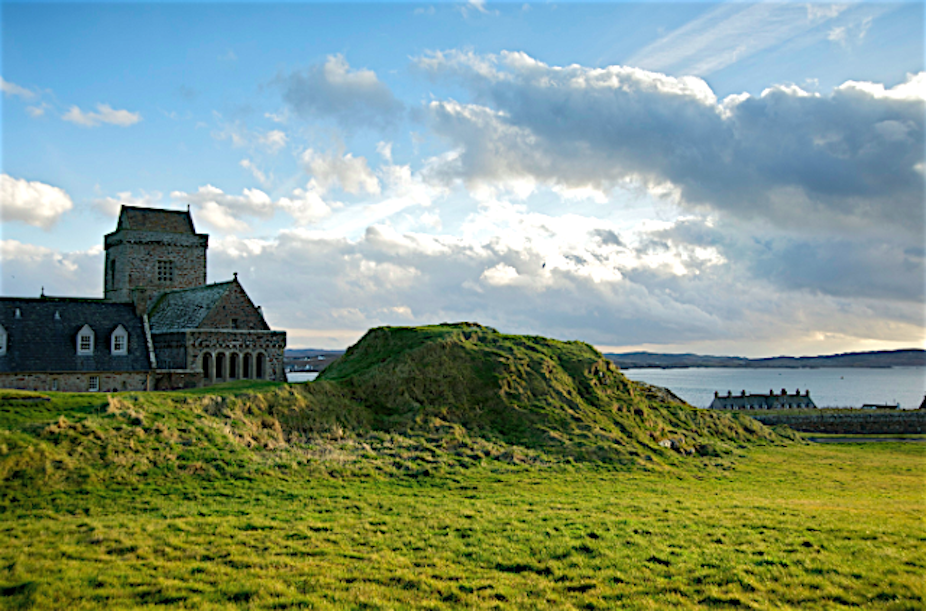“Beware, my son,” St Columba warned his disciple Berchán. “Do not come to my lodging tonight.”
But young Berchán crept to Columba’s house that night, peered through the keyhole, and witnessed a blinding heavenly light. He immediately ran away.
The next day the all-seeing saint scolded him. He added with fatherly exasperation: “If I had not in that instant prayed for your sake, you would have dropped dead by the door or else your eyes would have been torn from their sockets”.

Columba is the Irish monk who became the most important Scottish saint of his era. He founded a monastery in 563AD on Iona, an island off the west coast of Scotland, which became one of the leading intellectual and artistic centres of northern Europe. With the help of stories about miracles such as the one above, Columba is often credited with converting Scotland’s pagan Picts to Christianity.
A vital part of Columba’s legend is the writing hut or monastic cell where he is said to have copied scriptures and received students. But despite previous efforts to prove its existence, archaeologists had long believed the evidence was not available – and that little or nothing remains of Columba’s time.
We have been able to show otherwise. This is the story of how colleagues and I found compelling evidence that Columba’s hut really did exist, completing what a great team of archaeologists started decades earlier.
Digging for glory
Columba’s monastery stood on Iona until it was replaced at the beginning of the 1200s by the Benedictine abbey that remains today. The iconic “Celtic” ringed high cross was created here, and maybe also the Book of Kells, a famous manuscript of the Gospels. The place came to be so holy that generations of Scottish and Irish and even Norwegian kings are buried nearby.

Our main source of information about Columba is his biography Vita Sancti Columbae, written in 697AD by his successor Adomnán. Produced a century after Columba’s death, it describes Iona as a pilgrimage landscape. It tells of important moments from Columba’s life whose locations are now marked with crosses, while his grave was marked with the stone he apparently used as a pillow.
Adomnán describes both Columba’s writing hut or “tegoriolum” and his lodging (“hospitiolum”), where the saint slept and also trained disciples. Both were settings for miracles and prophetic visions, and may in fact be the same place.
The hut is specifically described as being on a raised place looking east out over the Sound of Iona to the rocks of Mull. There is a rocky outcrop within the monastic core of the site known as Tòrr an Aba (“the mound of the abbot”) which fits the description perfectly. Standing there today, one looks out over impossibly blue water out to the pink granite of the neighbouring island of Mull. It certainly feels like a good place to ponder divinity and receive the occasional angelic visitor.

Just over 60 years ago, a team of archaeologists was invited to Iona to find out if anything survived of the monastery. All in their twenties, they were led by Charles Thomas, who would become the premier scholar of early Christianity in Britain and Ireland.
One of the first places they investigated was Tòrr an Aba. The rocky mound was overgrown with grass, but there were antiquarian reports of a cross having stood there. The team quickly located the socket for a cross and noticed it was built over an earlier structure.

In 1957 they exposed this area and found the remains of a small wattle hut. The burned down structure had been buried under pebbles, and the cross base had been set up over it.
Thomas reviewed the evidence and contacted historians to discuss the possibility that this was indeed Columba’s hut. Today, archaeologists would collect samples of the burned wood for radiocarbon dating, but this was not widely available in the 1950s. Nonetheless, the excavators did take samples.
For various reasons, Thomas never published his work. The excavators of the hut, Peter and Elizabeth Fowler, would publish their findings in 1988, but by that point the samples were missing. They made the best case they could, saying they believed but couldn’t prove it was Columba’s hut. The consensus became that the remains of Columba’s time on Iona were perhaps too fragmentary to prove.
Second coming
Fast forward to 2012. Historic Scotland, predecessor of Historic Environment Scotland, now managed the site. I was helping renew its displays along with researchers at the University of Glasgow – the historian Katherine Forsyth was researching the collection of carved stones, while Ewan Campbell researched the archaeological background.
It became apparent that Thomas’ unpublished excavations were crucial to both investigations. At 84, Thomas agreed to transfer his Iona archive to Historic Scotland. I was lucky enough to meet him in his home in Truro to collect boxes of material which had lain in his garage since his retirement.
After rigorous detective work generously funded by Historic Environment Scotland, Ewan Campbell and I finally sorted out the scattered notes, drawings and photographs into a data structure report describing each trench and its contents. Amongst this material was a wonderful surprise – small boxes of charcoal, including some marked “Cutting 10” – the trench containing the wooden hut.

Charles Thomas sadly died in 2016 before we got the results. The radiocarbon lab at Scottish Universities Environmental Research Centre has confirmed that two samples of hazel charcoal from the hut dated from between AD 540 and AD 650, likely to be from the lifetime of St Columba. Later marked by a cross, the hut was almost certainly his.
Exciting as this is for me as an archaeologist of early Christianity, perhaps more exciting is to vindicate Charles Thomas, whose work continues to inspire my research. The consensus about Iona is being overturned thanks to Thomas’ work. Now we are going to see what else he may have found. You can read more about our project here.

